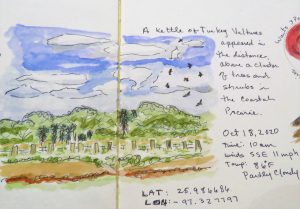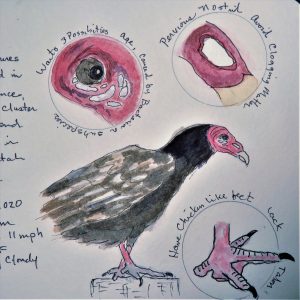by Maria Reyna-Gomez
Based on my areas of interest, I attended three presentations in our Virtual Annual TMN Meeting in October. I have woven my take aways and my resulting action into this article.
Learn, Do, Reflect, and Share was the message I took away from the “The Personal Botany Field Trip” by Lori Buffum and John & Karen Gardner of the Gideon Lincecum Chapter. In this session, the Education Directors explained how they overcame a class dilemma when the pandemic hit in March. The Gideon Lincecum Chapter was in the midst of the new class training and needed an alternative way to incorporate a field trip. During the session, they shared the outline of the assignment given to the new class members. The students were to go out and choose three plants, record their observation, complete the provided outline, and format a presentation for sharing.
I learned how essential vultures are to our environment from “Vulture: The Private Life of an Unloved Bird” by Katie Fallon. Katie talked about vultures of the world and the threats the vultures face. She reported on the vultures in North America and described the sub-species, migratory paths, diet, habitat, and breeding. She explained how the vultures play an important role in our ecosystems by disposing of carrion (the decaying flesh of dead animals, including humans) that would otherwise contaminate the waters, soils, and air.
Always pay close attention and record what you see. Now. In the present. If you do this, it will help you remember and relive the experience in the future, was my take from “Try Out Nature Journaling” by Irmi Willcockson, a Master Naturalist from the Gulf Coast Chapter. Nature journaling encourages a person to slow down, pay attention, and have personal records. It allows a person to look back and relive the experience. A nature journalist uses pictures (sketches, drawings, photographs), words (descriptions, labels, poems), and numbers (how long, how many, how often) to describe the observation or experience. This session was a repeat for me. The week before I had attended a virtual nature journaling conference “Wild Wonder 2020” hosted by John Muir Laws and the Nature Journal Club.

Listening to these three sessions and taking notes was not enough! I decided to put some of what I had learned to practice. What follows is an approach I took to in the hopes of becoming a better naturalist.
With class notes, journal, pen, camera, and binoculars in hand, I drove out one Sunday morning in search of Turkey Vultures. It was not long before I came up to a kettle of Turkey Vultures in the distance near the Port of Brownsville. I watched them as they circled and ascended the sky. In my journal I noted the date, time, weather, coordinates, counted the number of birds, and other observations. I settled down to sketch in my nature journal… a small landscape depicting the kettle in the distance. After the birds were no longer visible in the horizon, I drove around in hopes of finding a vulture I could photograph. Without luck, I returned home.

Once home, I remembered my husband taking pictures of turkey vultures and I searched my computer files. I found the perfect reference photo which I could use as I continued journaling my observations. In my nature journal, I sketched the vulture’s distinctive features (nostril area, warts around the eyes, and the chicken-like feet).
I proceeded with an internet research for more information on vultures of North America. I will not write about the details of the birds, but I will direct you to search the RGVCTMN website. There are several archived articles pertaining to Turkey Vultures. There is also a Turkey Vulture article in this issue of the newsletter.
Katie mentioned that vultures are now using communication towers to roost. I remembered that on previous occasions I had seen several vultures perched at a communication tower on Hwy 48 near the Shrimp Basin at the Port of Brownsville. For two days, I drove to the location after work. I found that there are approximately 50 turkey vultures coming to roost at this tower.

One by one each vulture glides in and settles down on the tower lattice framework or on the communication equipment and antenna area. I noted that no matter from which direction they initially fly in from, the vultures will line up with the tower and glide in against the wind. The last bird showed up no later than 6:45 pm. On only one occasion I observed seven vultures approach the tower all at once. With this last observation, I completed my nature journal and my personal study of Turkey Vultures.
In summary, I learned by studying, observing, documenting, sketching, and sharing my adventure with you. I am feeling gratified that not only was I able to attend the TMN Virtual Annual Conference, but that I put what I learned into practice and had fun doing it.
